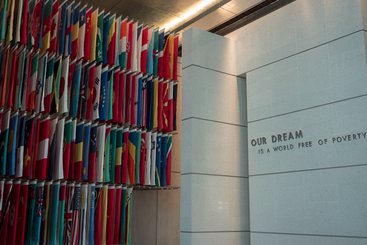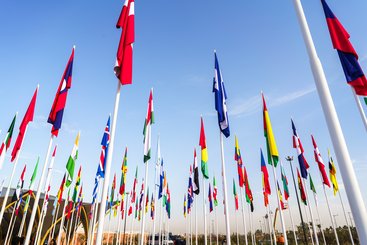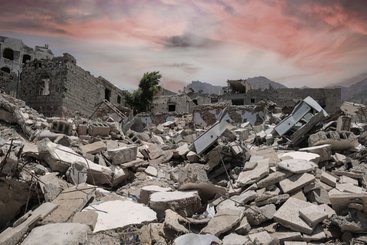During this month’s World Bank-IMF Spring Meetings, ODI, one of the world’s leading global affairs and development think tanks, with its new presence in Washington, D.C., will convene leaders from multilateral development banks (MDBs), development finance institutions (DFIs), and governments to discuss how the development finance architecture can be restructured to better serve poorer people and vulnerable countries and to drive the new green economy.
ODI-hosted events will focus on increasing financing in Small Island Developing States (SIDS), better recognizing the value of callable capital from MDBs, improving country climate financing platforms, and better serving underserved groups at scale.
ODI Day at the Spring Meetings
Join us for a series of events that will explore some of the world's most pressing challenges in development finance.

The development finance model isn’t working for everyone
Investment is not flowing to the places and the people where it is most needed. It certainly is not being offered on terms to help people and countries emerge from poverty. The development finance model is not working for underserved groups.
Who are Underserved Groups?
- Underserved geographies, i.e., low-income countries, fragile states, SIDS, and rural areas.
- Underserved people, e.g., women, indigenous groups, religious minorities, people with disabilities, LGBTQ+, Afro-descendants in Latin America, former combatants.
- Underserved borrowers, e.g., African entrepreneurs, small-holder farmers, green technology, market workers who need small loans, infrastructure to drive sustainable growth.
As the world’s wealthy countries invest unprecedented amounts of money into their own economies, poor countries need more than aid. They need a fair share of the new economy.
DFIs, MDBs, and the IMF have invested hundreds of billions of dollars in recent decades, with many successes; yet only 7 countries have emerged from least developed country status in the last 50 years. Income gaps in countries continue to grow. What worked for the countries emerging from World War II, who benefited from the development finance architecture designed 80 years ago, is not meeting today’s needs.
Development finance seems to mostly benefit wealthier investors in middle and even high-income countries, as well as established families and institutions in low-income countries. ODI conducts extensive research and analysis and provides recommendations on how to improve development finance. We need DFIs, MDBs, and their shareholders to take action on these recommendations.
MDBs and DFIs – and shareholders – must move further outside their comfort zones
To address the crises of climate, poverty, fragility, and inclusion, MDBs and DFIs must scale their financing. They make announcements and undertake sincere efforts, but they need to step much further outside their comfort zones, as do their shareholders. Their shareholders expect them to advance development and still earn a financial return. But are they reaching their full potential in advancing development? And should they focus so heavily on financial returns when planned “losses” such as when DFIs or MDBs assume depreciation risk on local currency loans, can leverage multiples of private investment?
Many small-holder farmers can access financing. But that usually involves DFIs lending U.S. dollars to a bank or another financial intermediary, which then lends money to a farming cooperative, which then gives loans to farmers. Everyone gets their cut of a few percentage points, which means that the farmers can end up paying interest rates of upwards of 30%. That approach really is not fair or sustainable. Why do these public institutions need to get a cut if their goal is advance development?
Similarly, some African entrepreneurs who participated in the Stanford SEED program that trains and provides resources to start-up companies shared that local banks denied them credit despite owning homes to use collateral because their houses are in the “wrong” neighborhoods. Some were from a different ethnic group than those running the local bank. We can do better.
Stronger support for private and local development banks is needed
With the heavy focus on localization of development aid, why isn’t there deeper discussion about how DFIs and MDBs can strengthen their support for local development banks through efforts like Finance in Common? They should be lending the local development banks money at or even below cost and providing them with non-repayable technical assistance so that the local banks can reach more customers. MDBs and DFIs should be working to put themselves out of business by strengthening private and local development banks.
Accelerating the climate agenda faces its own financing challenges. Public institutions need to be the “first movers” on new technologies to drive down the cost curve for others, particularly for those in the Global South. If MDBs and DFIs prioritize development impact above all else, they would take on that technology risk at scale. Yet many continue to invest in projects already known to be commercially viable such as solar projects in India – a country with more with 180 gigawatts of renewable energy, which is three times the amount of renewable energy on the entire African continent of more than 50 countries. Why did only eight solar projects reach financial close on the entire African continent in 2023? MDBs and DFIs must focus even more on Africa.
We can fix this. If we don’t, the world’s poor and vulnerable will be left further and further behind over the next century. The growing growing chorus calling for change is loud, including efforts like the Bridgetown Initiative.
A Plan of Action for the Spring Meetings and beyond
It has become clear that during the Spring Meetings, we must push for Calls to Action and Plans of Action – not just for the World Bank and IMF, but for all multilateral and bilateral development finance institutions to change the way they conduct business. ODI has deep experience helping implement recommendations through its ODI Fellowship Scheme that has embedded economists in government ministries throughout the world for more than 60 years. Achieving these changes, though, requires a multi-prong approach among the development finance institutions themselves, including:
Making internal policy changes:
- Changing their risk appetite.
- Simplifying approval processes.
- Financing smaller ticket sizes, etc.
Dedicating resources:
- Dedicating staff exclusively focused on investments targeting underserved groups.
- Providing non-reimbursable technical assistance.
- Aggressively using blended financing, when it will increase development impact.
- Tapping into callable capital, reallocating of Special Drawing Rights, and seeking capital increases.
Changing expectations of shareholders/stakeholders:
- Eliminating requirements for institutions to operate at 100% capital preservation like the U.S. International Development Finance Corporation.
- Shifting more development aid from aid agencies to development finance institutions to offset portfolio “losses” so that transactions can be priced for development impact rather than risk.
- Lending to local development banks at or below cost to support localization.
Changing incentive structures within organizations:
- Rewarding staff for achieving development metrics, not investment metrics.
- Rewarding staff for getting difficult transactions across the finish line.
Using different tools (e.g., guarantees, local currency lending, insurance):
- Taking on at least some level of local currency risk, when appropriate.
- Scaling guarantee instruments that may cost lending institutions more money, but that can leverage greater private investment – a great use of development aid money.
- Providing different types of insurance instruments, including off-take insurance for energy transactions, to encourage private entities to make investments.
We know that the development finance architecture has worked for many countries, but it is failing in many ways. We can write and talk about it, or we can do something about it.
Let’s hope that the World Bank-IMF Spring Meetings will be the place where leaders will move from pen to paper to action and will start making the changes needed to address the development issues of our century.


